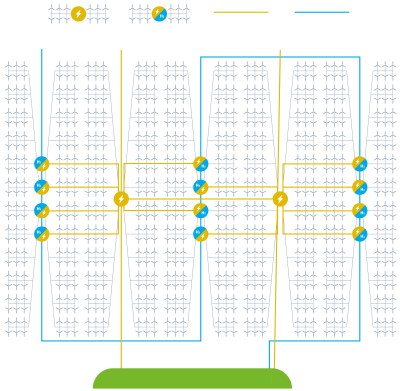Build for the future today
When building the North Sea green power plant, we are building for both now and the future. We can already anticipate significant technological leaps over the coming years, making new solutions available to generate, convert, and transmit energy
The solution is a modular build-out of a hub- and-spoke system – a design principle that gives increased flexibility and more options moving forward as new technology is introduced. Modularity means not designing for just one specific technology but making sure that the first hub build can connect with later hubs in an integrated system. This means different technologies can supplement each other down the road.
The challenge
Building for the future is difficult. The design choices we make today must anticipate technological innovations and regulatory and market conditions in 2050 and beyond. Can we make intelligent choices today to make sure what is built now is also good for the long run?
This can be compared to LEGO bricks. They come in many colours and shapes. They have developed massively from simple rectangular shapes into new and elaborate designs. At the core of the technology, the studs that allow every LEGO brick to connect with any other brick are the same. So what you build in the beginning does not determine where you end up. The solution becomes a platform that you can expand upon, without needing to tear down what you first assembled.
To achieve this, it is necessary to make all the parts of the hub-and-spoke concept work and fit together in a standardized design. Extensive work by the North Sea Wind Power Hub consortium has shown that this is possible. The results cover all elements of a hub-and-spoke project including the underwater substructure, the electric system for transforming and distributing power to the grid, and more.
A modular build-out can be more expensive. It requires extra investment of 10-15% of the costs today as opposed to a solution that is only optimised for the short term and doesn’t have the flexibility that comes with a modular design. But this extra investment today makes sense. It will be cost-effective and could potentially save billions in the future.
The insight
A modular build-out of hub-and-spoke projects is possible. This can ensure that an initial 2030 project will be compatible with design choices that follow towards 2050 and beyond. But it requires investment up front today that will only pay off in the long run.
Without a modular approach, there would be a need or wish to redesign the build-out to keep a high level of efficiency and to utilize the best technological approaches when we approach 2040 and 2050. These redesign phases are not cheap and can require large- scale reconfigurations of existing installations. With a modular approach, we can ensure that an initial 2030 project will be compatible with design choices that follow towards a 2050 final design of the North Sea green power plant.
For more information on the technical feasibility of hub-and-spoke elements, please see

